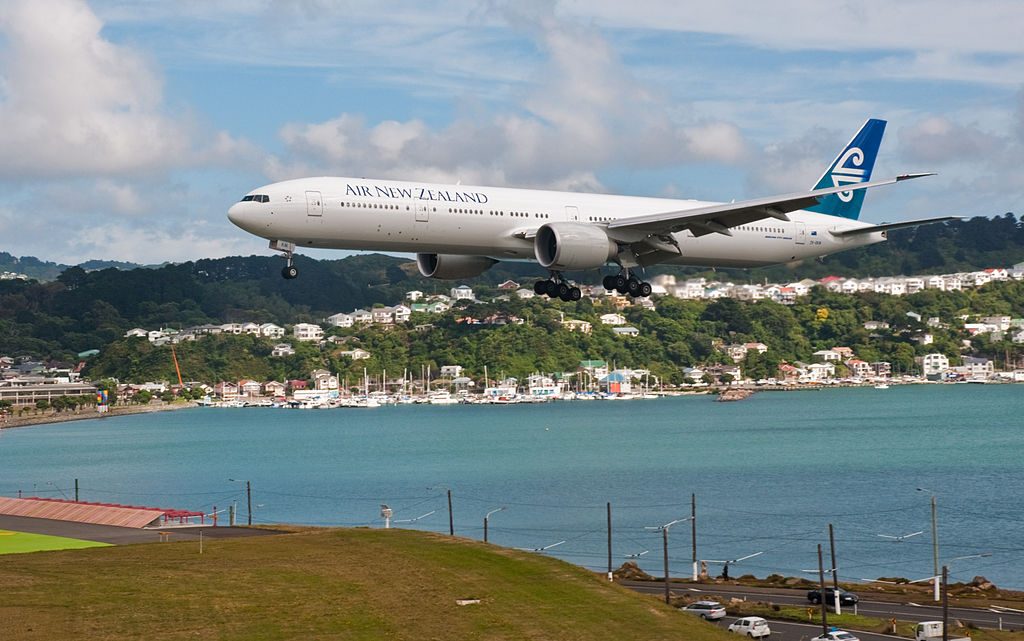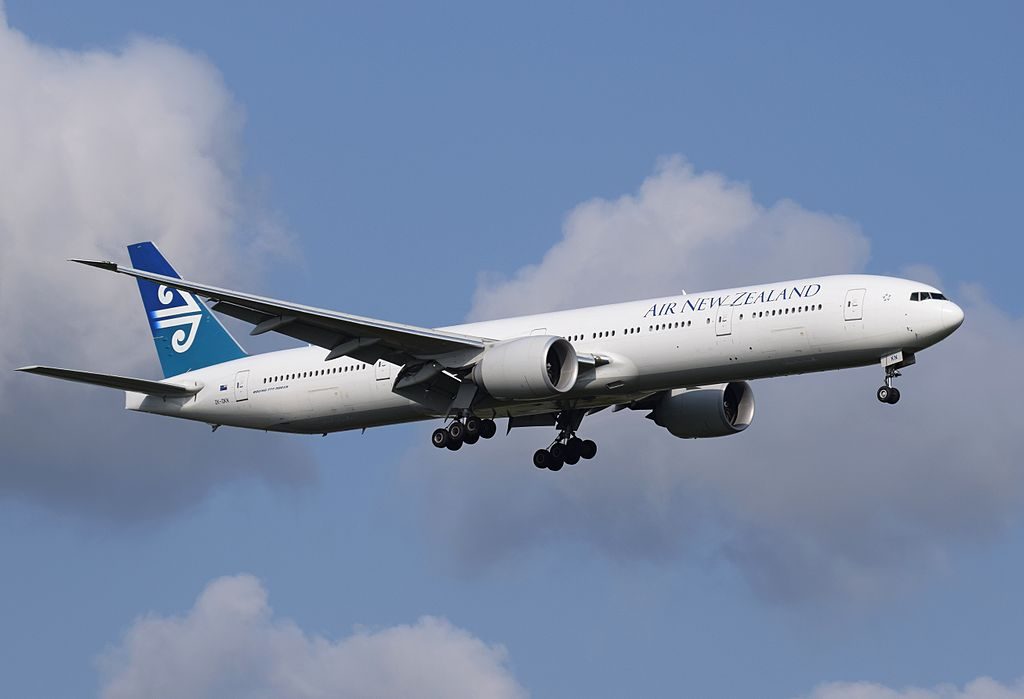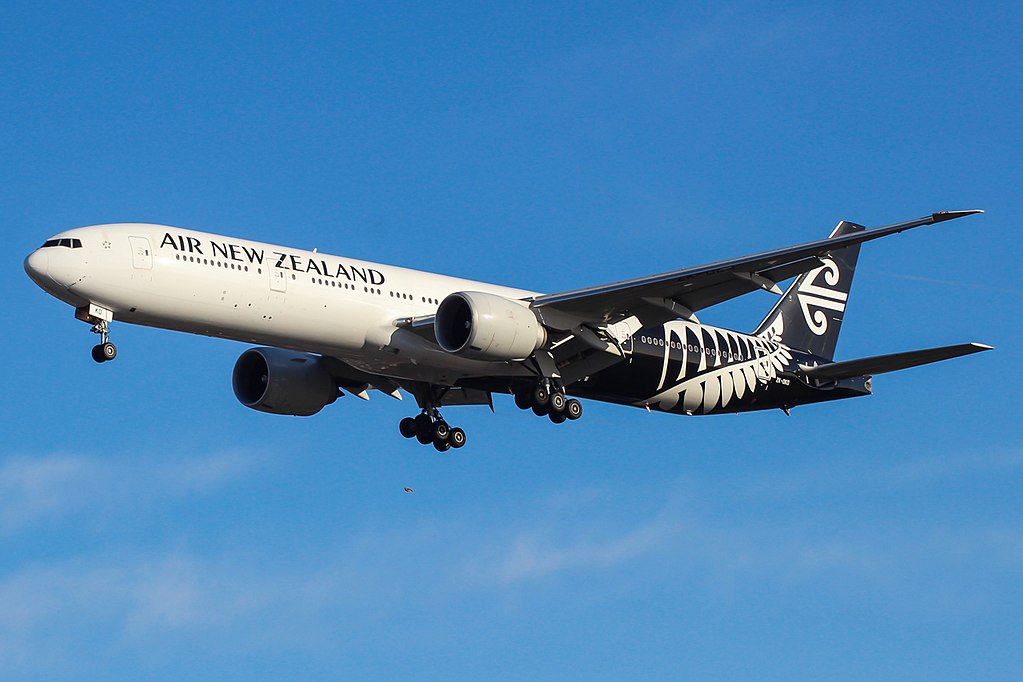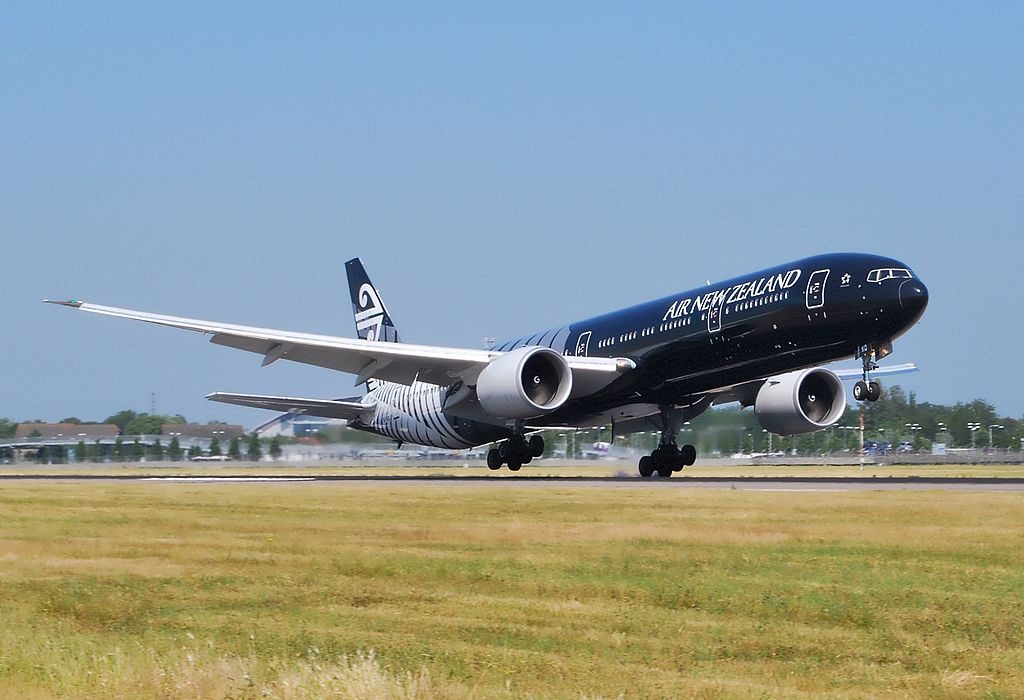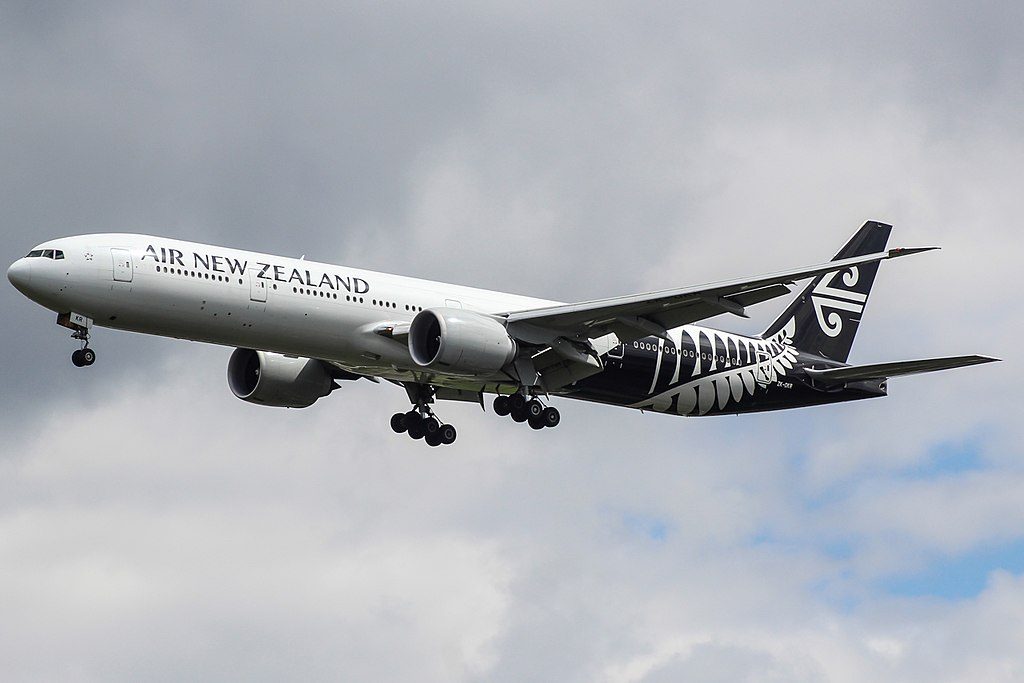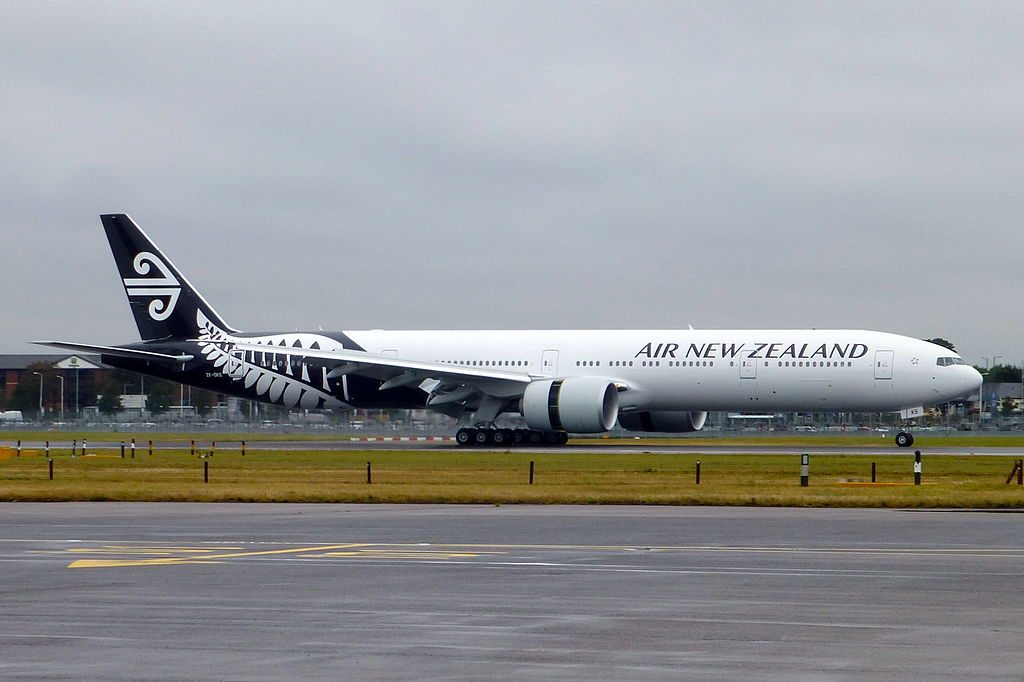Air New Zealand Fleet Boeing 777-300ER Details and Pictures. As of 31 January 2019, Air New Zealand operates 8 wide-body long-haul aircraft Boeing 777-300ER.
This Boeing 777-300ER may accommodate 332 passengers in three classes: business premier, premium economy and economy.
It is worth to mention that for today airplane Boeing 777-300ER that is able to transport 365 passengers on 14685 kilometers distance is the most sold passenger airplane of Boeing 777 family (777-200, 777-200ER, 777-200LR, 777-300, 777-300ER).
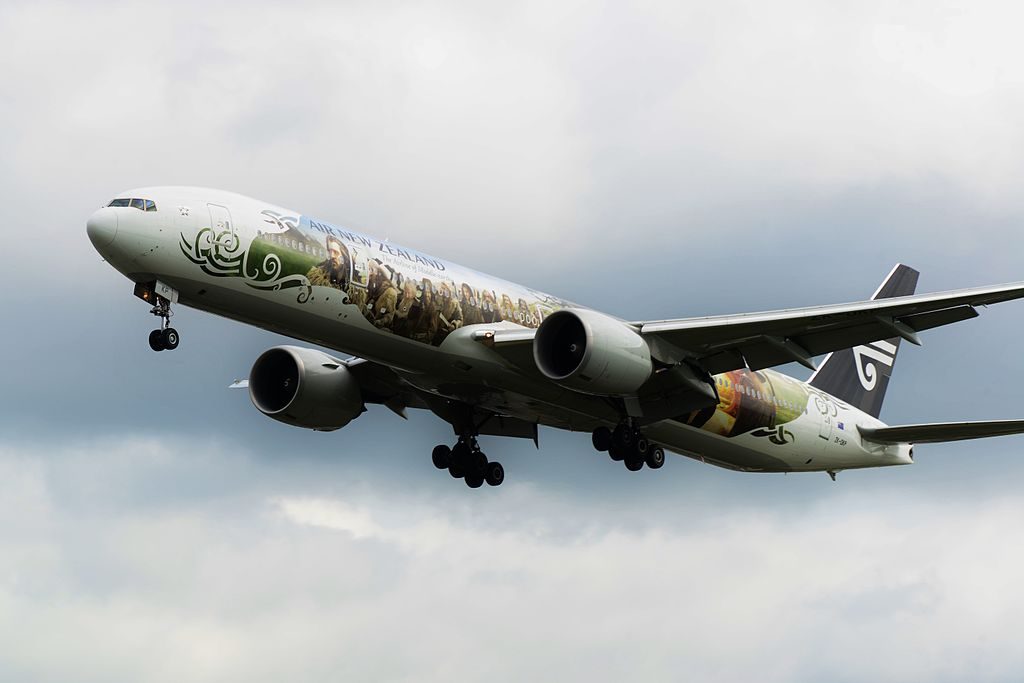
Boeing 777-300ER Air New Zealand Aircraft Fleet Data and Registration Number
| Aircraft Type | Reg | Delivered |
| Boeing 777-319(ER) | ZK-OKM | 20 Dec 2010 |
| Boeing 777-319(ER) | ZK-OKN | 15 Feb 2011 |
| Boeing 777-319(ER) | ZK-OKO | 22 Mar 2011 |
| Boeing 777-319(ER) | ZK-OKP | 7 Nov 2011 |
| Boeing 777-319(ER) | ZK-OKQ | 10 Jan 2012 |
| Boeing 777-319(ER) | ZK-OKR | 6 Jun 2014 |
| Boeing 777-319(ER) | ZK-OKS | 25 Sep 2014 |
| Boeing 777-35E(ER) | ZK-OKT | 8 Aug 2018 |
Air New Zealand Fleet Boeing 777-300ER Cabin Interior Class Configuration and Seats Layout
This 777-300ER series plane features Air New Zealand’s revolutionary new Skycouch for some Economy Class seats, new Premium Economy SpaceSeat and an improved Business Premier seat and service.
Economy Skycouch seats are featured on this aircraft and are available for purchase at an additional cost.
These seats are indicated in blue outline on its seat map.
Air New Zealand’s description states that the Economy Skycouch is a row of three Economy Class seats that together create a flexible space for whatever you want it to be – an area to relax and stretch out in, or for the kids to use as a play area.
It is like having your very own couch on the plane.
There’s 2 business premier cabin.
First cabin which is from row one to seven.
The second cabin, which is in front of premium economy, is across rows 9 to 12.
The product is arranged 1-2-1 (A, B-J, K) so everyone has direct aisle access.
In total there are 44 business class seats measuring 22 inches in width, and 79 inches when in fully flat mode (with 33 inches of shoulder room).
Like Virgin Atlantic’s Upper Class, they are in a herringbone formation so window seats are angled away from the windows.
They have the same shape as well, pods having low walls for a certain degree of privacy (more when lying down on the fully flat bed), plus off-white leather upholstery (aubergine for the ottoman, which doubles as a guest seat).
A button releases the seat, which folds forward to create a flat surface for sleeping on.
Menus and amenity kits (containing socks, an eyemask, Ashley and Co lip balm and moisturiser, a toothbrush and paste, mouthwash, a pen and a mint) were placed on the ottoman in front of each seat.
Bedding bundles and pillows were neatly piled behind the seat back.
There are USB and universal power sockets below the 11-inch touchscreen entertainment monitors, which also have a remote built in underneath.
Large, solid tables pop out of the side of the pod (crew tend to operate these when beginning the meal service) and there are smaller drinks trays that fold out next to the screens.
There is no wifi on board.
Rows one and two are nearest the galley at the front of the plane, while row seven and 12 are nearer the central galley so there can be some noise and cold air coming through, although the curtains remains shut for most of the flight.
The washrooms are closest to row nine and there are bassinets for babies behind seats 12B and 12J in premium economy, which could mean there is some disturbance if they start crying.
The second cabin is smaller, which some people might prefer.
Other than that, all the seats will offer the same level of comfort and aisle access.
Air New Zealand’s 777-300ER features a 2-4-2 premium economy cabin.
Each premium economy seat is 19.5 inches wide.
The pitch between rows is 41.5 inches, which allows enough space for you to slide past your neighbor when the seat in front of your neighbor isn’t reclined.
The recliner-style seats are covered in leather, and are particularly comfortable in the upright position.
There are two buttons on the armrest — the forward button deploys the legrest while the rear button reclines the seat.
The legrest didn’t fully extend automatically, but you could pull on it while pushing the button and it would fully extend.
The footrest extended from the legrest instead of being attached to the seat ahead of you.
You could fold out the footrest and then use a lever on the legrest to set the height of the footrest.
This type of footrest could be good, as shorter passengers could adjust the footrest to fit their needs.
Each seat had a single seatback pocket.
There was a safety card and motion sickness bag in the pocket, but no other material.
And since these seats didn’t have a hard shell, you could feel when the passenger behind you added or removed items from the pocket.
Although seat supports and inflight-entertainment boxes were located under the seats, there was ample under-seat space for personal items and legroom.
Plus, the overhead bins were large enough that most passengers could stow their personal items and carry-on items overhead.
There was a large headrest on every seat that could be raised to support taller passengers.
The headrest had wings to support your head while sleeping, but these wings were spaced far apart, so they didn’t provide adequate support without you bending your neck or leaning your body.
The tray table extended from the armrest.
The table came out in bifold form, and there was a cup divot in this form.
The bulkhead seats had the same legrest and footrest as the other premium economy seats, but they also had an IFE screen that extended from the armrest.
At the back of the premium economy cabin, there were two lavatories.
The premium economy cabin was curtained off from both business class and economy, so these lavatories were mostly used by premium economy passengers.
There were no special amenities, but they felt modern, and the flight attendants kept them well-stocked and clean throughout the flight.
Seat Map and Seating Chart Boeing 777-300ER Air New Zealand

First 11 rows of the airplane contain the seats of business premier class.
These seats are divided into 2 sections and have 1-2-1 configuration.
There are totally 44 flat bed seats of this class.
These seats can be transformed into a full-fledged bed.
First section of business premier class has 7 rows of seats.
Location of the galley in front and lack of overhead bins are the main disadvantages of the seats of the 1st row.
The noise from the galley and lavatories located behind will cause discomfort to passengers of the seats of the 7th row.
Behind the exit row 4 more sections of business premier class are located.
Passengers traveling with infants are often seated on the seats 9A and 9K because these seats of bassinets.
Proximity of the galleys and lavatory will represent problem for passengers of the seats of the 9th row.
Facing into the lavatories makes the seats 9B and 9J bad seats.
Situation when behind the seats 12A and 12K fly passengers with infants may be bothersome.
Behind the seats of business premier class 54 recliner seats of the premium economy class are located.
There are totally 8 rows of seats here.
7 rows have 2-4-2 configuration and 1 row contains 2 seats.
Passengers of the seats of the 23rd row will take advantage of extra legroom.
However, these seats are a little narrower than standard because the tray tables and video displays are in the armrests making them immovable and have no floor storage during take-off and landing.
The seats 23AB and 23JK are considered good seats.
For passengers with babies the seats 23DEFG have bassinets.
Close location of the lavatory and galley is the only disadvantage of the seats 28AB, 28JK, 29D and 29G.
Location of the seats of the 30th row between lavatories and proximity of the galley make these seats bad seats.
244 seats of the economy class are located in two sections.
Due to protrusion of the exit doors the legroom of the seats 34A and 34K is limited.
Also, passengers of these seats may get cold during the flight by the exits.
Passengers of the seats 34B and 34J on the contrary will take advantage of extra legroom.
For passengers with babies these seats offer bassinets.
The seats of the 34th row have some common disadvantages: reduced width ad lack of floor storage during take-off and landing.
Passengers traveling with infants are often seats on the seats 35B, 35DEFG and 35J.
Proximity of the galley may cause discomfort to passengers of these seats.
As the tray tables of the seats 35DEFG are built-in the armrests the width of these seats is reduced a little.
Lack of floor storage during take-off and landing is another disadvantage of these seats.
The seats 36C and 36H are considered the best seats because they offer additional space for passengers’ legs.
However, these seats are a little narrower than standard and have no floor storage during take-off and landing.
ABC and HJK seats of the rows 37-46 if purchased together with the neighbored seats may be converted to the Economy Skycouch seats because these seats have extendable foot rest rise of which transforms the common seats of economy class into a couch-like seat that provides passenger with additional personal space during long-haul flights.
The pitch of these seats is 33 inches.
The main disadvantage of the seats 46ABC, 46D, 46G and 46HJK is close location of the lavatory and galley behind.
The seats 47DEFG are considered bad seats because of limited recline, galley located behind and lavatories located on the both sides of the seats.
Second section of economy class seats consists of 13 rows.
Thanks to the exit row located in front the seats of the 48th row provide extra legroom.
Among disadvantages of these seats: lack of floor storage during take-of and landing, reduced width and proximity of the lavatories and galley.
Protrusion of the exit doors may cause some discomfort to passengers of the seats 48A and 48K.
For passengers with babies the seats 48C, 48DEFG and 48HJ are equipped with bassinets.
Due to missing seats behind, other passengers and crew members passing by may bump the seats 56C and 56H.
The noise from the galley and lavatories located behind will cause inconvenience to passengers of the seats 59AB, 59D, 59G, 59JK and 60DEFG.
Limited recline makes the seats 59AB, 59JK and 60DEFG bad seats.
Boeing 777-300ER Air New Zealand Seating configuration
| Class | Configuration | Seat pitch * |
|---|---|---|
| Business Premier | Rows 1 to 12 (44 seats) | Fully lie-flat bed |
| Premium Economy | Rows 23 to 30 (54 seats) | 41 – 42” (104 – 106cm) |
| Economy | Rows 34 to 60 (244 seats) | 32 – 33” (81 – 83cm) |
| Economy Skycouch™ | Rows 37 to 46, seats ABC and HJK | 33” (83cm) |
Boeing 777-300ER Air New Zealand Aircraft Fleet Inflight Amenities and On-Board Services Information
- Audio. This aircraft features OnDemand audio at every seat including 454 audio CD’s and 18 radio shows.
- Video. Each seat features a personal video screen and OnDemand video including 72 Movies, 881 Television Shows and 21 games. More Information
- AC Power. There are AC power, USB ports, and iPod docking capabilities at every seat.
- Food. On long-haul flights, Business and Economy passengers receive extensive meal choices and complimentary beverage service.
More Information
Air New Zealand Aircraft Fleet Wide-Body Boeing 777-300ER Images Gallery
Seat Map and Seating Chart Boeing 777 300ER Air New Zealand Air New Zealand ZK OKM Boeing 777 300ER at Wellington International Airport Air New Zealand Boeing 777 300ER ZK OKN arrives London Heathrow Airport Boeing 777 300ER ZK OKO Air New Zealand at London Heathrow Airport Air New Zealand The Hobbit ZK OKP Boeing 777 300ER at London Heathrow Airport Air New Zealand Boeing 777 300ER ZK OKQ All Blacks Livery touches down on 09Left at London Heathrow Airport ZK OKR Boeing 777 300ER Air New Zealand at London Heathrow Airport Boeing 777 300ER Air New Zealand ZK OKS at London Heathrow Airport
Thanks to visiting AirlinesFleet.com and read article : Air New Zealand Fleet Boeing 777-300ER Details and Pictures.
